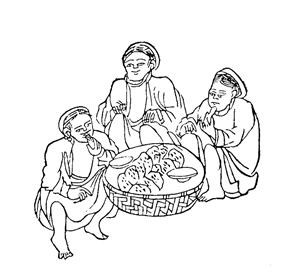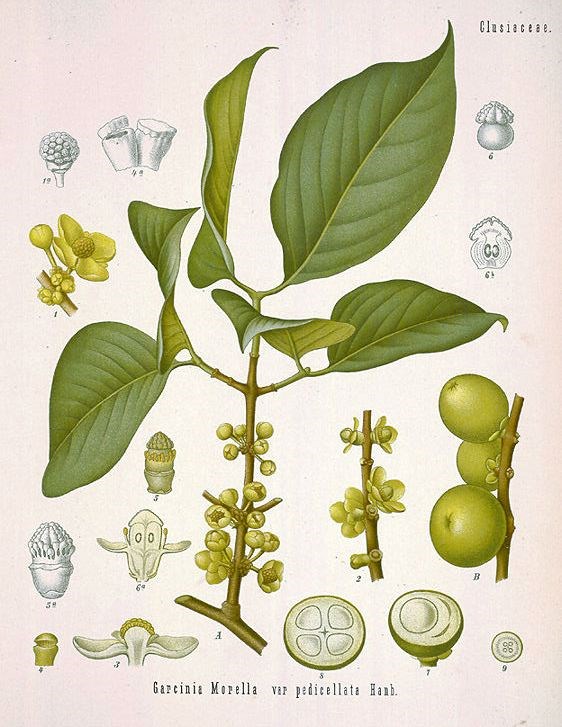1. We, young lumberjacks wandering in
the jungle then, used to look around for chamuang from time to time. A kilo of
dried fruits was 20 dong worth back in 1978, which means a fortune for anyone
who found a tree of this kind.
But
things did not come easy. Chamuang fruit looks like gamboge fruit with thicker
peel and juicy, succulent segments, but they did not get ripe regularly. It
takes twenty kilos of fresh fruit skin to produce one kilo of dry skin, which
is a perfect condiment for the famous bun rieu (freshwater crab noodle soup) as
well as other sour soup recipes thanks to its light and fresh sourness.

Street vendors. Painting in Technique du Peuple Annamite by Henri Oger.
The
Vietnamese has a wide range of ingredients to choose from to cook sour soup,
such as chamuang fruit, tomato, pickled bamboo shoot, dracontomelon, tamarind,
fermented rice, etc. Slurping sour soup is a very Vietnamese pure joy.
Speaking
of tastes, we often mention the set of bitter-spicy-sweet-nutty or
sour-spicy-sweet-nutty; though bitterness plays a less important role in
seasoning, there is also bitter bamboo shoot, bitter gourd coupled with other
flavours. Salty, bland, pungent, aromatic, smelly or bold are only a few notes
that words can describe, others are left indescribable.
Taste,
in other words, means one’s dining
preference. Gradually its initial meaning grows culture-related, through
which helps shape each people’s traits. For instance, bitter and sweet
themselves form a unique pair to talk about one’s emotional experiences.
Another example, the phrase “a time of hotter ginger and brinier salt” means
sticking with each other through ups and downs. Also, tastes have long made
their appearance in this line in folk literature,
It
only costs three dong to buy a betel leaf, why don’t you ask for my hand
earlier when I was still young?
Embittered,
on the other hand, is a cry for disappointment and frustration when misfortune
keeps coming around.
In
The Chronicles of the Eastern Zhou Kingdoms, King Goujian of Yue lost his war
to King Fuchai of Wu. As a result, he was captured and served as Fuchai’s
servant. He was forced to taste King of Wu’s feces to diagnose his well-being,
which caused his stinky breath. After three years, he was released, however, in
order to remember the humiliations while serving under Fuchai, he forced
himself to taste bile often times. Sleeping on sticks and tasting bile,
therefore, became an idiom indicating the hardship soon-to-be heroes have to
endure. Nguyen Trai, a mandarin, militant and scholar who wrote Great
Proclamation upon the Pacification of the Wu, also used the same phrase to
describe Le Loi’s resistance force of Lam Son during their war: tasting bile
and sleeping on sticks will not take a day or two.

Chamuang fruits is not only an ingredient in sour soup recipes, but also a natural medicine. Photo courtesy: Internet
2. We do not know yet whether the
taste is formed by human’s social preference or just our plain curiosity.
Seemingly there used to be a wish to try all different tastes happening in our
hard times that they, eventually, become a daily routine.
Of
peoples around the globe, the Vietnamese is considered those with strong taste.
Vietnamese farmers prefer very salty food, whereas, Hue and Southern food are
pretty spicy. In some countries, it is quite hard to find strong seasonings
unless they are served at a themed restaurant. People’s taste these days are
fusing and sweet-like. Of course, who does not like sweet treats? Even animals
love sweet bites. Restaurant fare is becoming neutrally tasted, which is not
too salty, spicy, sour or sweet – a so-called communal flavour.
3. As previously mentioned, in
Vietnam sourness can be found in different types of condiments, two of which
are man-made, vinegar and fermented rice.
Fermented
rice is a Vietnamese typical creation. Partly stale cooked rice is stacked in a
vat to ferment until distinctly sour. The milky liquid retained after sieving
is later added to tomato crab broth or fish sour soup.
Vinegar,
on the other hand, is common sour solution. Farmers in the past usually made it
using a banana or sugar water. Without vinegar, dipping sauces of banh cuon or
bun cha would be bland.
Lime
and kumquat, which are natural medicines, both taste extremely sour. Their
juice makes up a fancy cup of summer drink. As for other sour fruits including
chamuang, tomato, tamarind, or dracontomelon, they are alternately used up to
one’s liking. Tamarind and dracontomelon, whose fruits are used to make
saladitos or favourite sour treats for ladies, grow from trees with large
foliage. Meanwhile, tomato, which has less acidity, is only a kind of
vegetables. Although chamuang is not quite popular; its taste is unique. Doc
fruit (garcinia multiflora) has to be broiled and peeled before adding to the
soup.
In
the land of sunlight and dampness, a big bowl of sour soup is a savior for
those with bloated stomach. Pickled cucumber has high acidity, and is consumed
as daily side dish.
“My house has a full
vat of pickled cucumber,
a pond of water
spinach and a barrel of bean paste
Though they’re no
gourmet dishes,
I dedicate all to my
parents and siblings.”
(Folk poetry)
People
certainly cannot eat spicy, sour or bitter food all day, except for sweet. A
bit of everything will spice up our lives. Some love spicy food, others prefer
sweets, while not many are keen on sour and bitter fare since they are more
supposed for aftertaste. But who knows? Since still there is an old saying:
“I don’t mind
throwing myself
into places as
astringent as figs, as spicy as chili;
And there is no way
that I am falling for either silky dresses, red hammock or gold hookah with
silver linings*.”
(Folk poetry)
By Phan Cam Thuong, 2013/
The thao & Van hoa
Cuoi tuan
*Symbols
of wealthy life